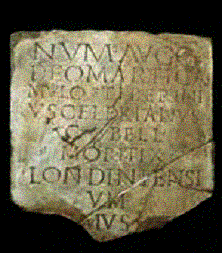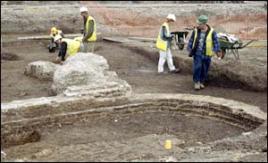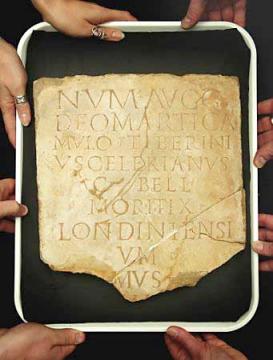MORITIX LONDINIENSIUM: A RECENT EPIGRAPHIC FIND IN LONDON
On 11 October 2002 various news agencies reported that archaeologists excavating a site in Southwark had unearthed a marble plaque inscribed with what may be the earliest known epigraphic attestation of London's Latin name from the environs of the capital itself. 'This is hugely important,' Francis Grew, curator of archaeology at the Museum of London, told reporters. 'It is the first real monumental inscription with the word Londinium on it.' The stone bears a religious dedication by an individual who describes himself by the mysterious title of moritix Londiniensium.

The new inscription (Photograph: BBC)This exciting find turned up just six weeks into a 40-week dig by rescue archaeology specialists, Pre-Construct Archaeology, on a one-hectare site at the junction of Tabard Street and Long Lane, SE1, which is destined to be covered by the Tabard Square development by Berkeley Homes. The site lies just south of the river Thames, at the convergence of two major Roman roads - Watling Street (A2), bringing traffic from the Kent channel ports, and Stane Street (A3/A24/A29), linking London to Chichester and the ports of the south coast. From here the road then crossed over the river to the walled city of Londinium proper on the north bank. This situation at such a nodal point naturally suggests the commercial significance of the location. One of the archaeologists, Gary Brown, said in an interview with Peter Macdiarmid, 'We have had a remarkable post-medieval phase and could be uncovering a significant prehistoric landscape also. ... I can't stress how important this site is. We have already gone back to the pre-historic occupation of the site and we have found vast quantities of artefacts.' He added, 'We have so far only dug 15 percent of the site and we have already found this plaque, so the potential for more staggering finds is there. Who knows what more we will find?'

The Tabard Street excavation (Photograph: BBC)The plaque, measuring approximately 12 inches by 16 inches and of a sandy-coloured imported Italian marble, was recovered on 3 October from the fill of a pit near the remains of two substantial Roman brick buildings of, as yet, uncertain function; speculation has ranged from headquarters of collegia (traders' guilds) to suburban villas. Although broken into two pieces, the edges of the plaque are intact on three sides. However, the stone is broken at the bottom, where, after eight completely preserved lines of text, several letters of a ninth line and traces of a tenth are visible. The text is carefully laid out and inscribed in beautifully clear standard Latin monumental capitals of c. 3 cms high, though with some deliberate variation from line to line. Even the punctuation is of high quality. As well as hederae (ivy leaves), the stone-cutter has used an elegantly executed three-strand 'peeled banana-type' emblem for the interpuncts. Indeed Francis Grew declared it to be 'visually the most important inscription we have ever found in London. The words are just as clear as people would have seen them 2,000 years ago.' After conservation the stone will go on display at the Cuming Museum, 155-157 Walworth Rd (above Newington Library), London SE17 1RS.
Diplomatic transcription:
NVM·AVGG
DEOMARTICA
MVLO · TIBERINI
VSCELERIANVS
C · BELL·
(leaf ) MORITIX·
LONDINIENSI
VM (leaf )
[. .]IMVS · [---]
[ --- ] ++ [ --- ]
(Photo: Reuters)
The inscription opens with a dedication to the numen (divine power) of plural emperors, which, despite the dating of c. AD 50-150 reported in the Press, indicates an Antonine date at the earliest (under Marcus Aurelius and Lucius Verus, AD 161-169, or Marcus and Commodus, 177-180) and it might equally well suit a Severan (under Septimius Severus and Caracalla, 198-209, or Caracalla and Geta, 211-212) or later date. However, the archaeologists report that the plaque was found in association with pottery of late second-century date. Assuming deposition as the result of deliberate discarding after some time on display, an Antonine date seems a reasonable hypothesis. The initial dedication to the numina Augustorum is combined with one to the god Mars Camulus, a syncresis of Roman Mars with a Celtic deity. Although Camulus is the eponym of Camulodunum (Colchester) and a number of other places in Roman Britain, there is only one other dedication to Mars Camulus known from Britain: an altar erected by soldiers of the auxiliary cohors I Hamiorum sagittariorum from the Antonine Wall fort at Bar Hill, Dumbartonshire (RIB2 2166 add., p.797). In fact, this particular manifestation of Mars is most predominantly attested in the area of northern Gaul and Germany between the Seine and the Rhine, being particularly associated with Reims (Durocortorum Remorum). There was a temple of Mars Camulus in that city (AE 1935, 64), altars dedicated at Worms (Borbetomagus: CIL XIII 6226) and Mainz (Moguntiacum: CIL XIII 11818), a large sanctuary of the god at Kruishoutem in the territory of the Menapii (AE 1992, 1244), another outside Orolaunum (Arlon: CIL XIII 3980, AE 1989, 537), and a further temple at Rindern (Harenatium) on the lower Rhine, erected, significantly, by a group of ciues Remi (CIL XIII 8701 = AE 1980, 656). The one dedication from Rome that mentions Camulus is also by a ciuis Remus (CIL VI 46; cf. AE 1992, 76). A dedication from as far away as Sarmizegetusa in Dacia also exhibits a direct link to the area, since the dedicator had previously served as procurator of Belgica and the two Germanies (AE 1998, 1100). Indeed, even the 'Syrian' archers responsible for the Bar Hill altar may be ciu[e]s G[alli] (line 5; cf. RIB 1593-94, 2100, 2148 for parallels). All of which suggests that the dedicator, Tiberinius Celerianus, had connections with that region.Although rare as a nomen itself, Tiberinius belongs to the category of nomina based on Latin cognomina (Tiberinus => Tiberinius) that is typical of the region of northern Gaul. In fact, a Tiberinia Seruanda is attested at Fectio (Vechten) on the lower Rhine (CIL XIII 8817). Despite its blandness, neither does Celerianus seem all that common. A quick search reveals four examples from Rome (CIL VI 14306, 31369-70, AE 1975, 54, AE 1977, 72) - the second of them a praefectus vehiculorum of AD 226 - one from Tarragona (AE 1955, 246), a magistrate from Noviodunum in Moesia (AE 1980, 836), and, more pertinently, a L. Gellius Celerianus ciuis Nemes (i.e. from Speyer on the Rhine: CIL XIII 6659), as well as a further Celerianus who is named on a fourth-century curse tablet from Bath (AE 1982, 667). Given the strong Gallic connections of Mars Camulus and the style of Celerianus' nomen, the otherwise enigmatic C. BELL. of line 5, may be resolved as a designation of Celerianus' origo as c(iuis) Bell(ouacus), 'citizen of Beauvais' (Caesaromagus Bellouacorum).
This overseas origin may then form a deliberate counterpoint to a position of local standing as moritix 'of the Londoners' or, alternatively, as suggested by Guy de la Bedoyère, 'of London things (Londiniensia)'. Although unknown to Lewis & Short or The Oxford Latin Dictionary, A.R. Birley (The People of Roman Britain [1979], p.126), does produce two possible parallels for our moritix and suggests a Celtic etymology for the term. One example is from Britain, the other from the Rhineland but with clear links to this island. The latter, a certain C. Aurelius C. l. Verus negotiator Britannicianus moritex, dedicated an altar to Apollo at Köln (AE 1893, 31 = CIL XIII 8164a = ILS 7522). Verus' self-description was glossed by Birley as 'shipper in the British trade'. The former, M. Verec(undius) [Diogenes], although a ciuis Biturix Cubus (i.e. from Bourges), had a sarcophagus made for himself at York, where he was [se]uir col(oniae) Ebor(acensis) ibidemq(ue) morit(ex) at some time in the third century (RIB 678 = RCHM Eburacum I [1962], p. 131a, no 110; cf. RIB 687). Both of these examples exhibit cross-channel connections as well as certain or likely freedman status (Verus is Caii libertus and Diogenes not only has a Greek cognomen but is also a seuir Augustalis - both strong indicators of freedman status). This leaves the problem of how to take moritex. Is it to be understood in reference to their cross-channel activities or rather as a quasi-magisterial functionary (within a collegium of Augustales or of traders) defined in relation to the local municipality? Perhaps the two possibilities should not be considered as necessarily mutually exclusive (see D.J. Breeze, 'Supplying the army' in G. Alföldy, B. Dobson, W. Eck [edd.], Kaiser, Heer und Gesellschaft in der Römischen Kaiserzeit [2000], pp. 59-64). The hypothesis that moritix is a professional description is presumably the basis for the suggestion that the inscription may have come from the headquarters of a collegium of traders.
The leaf decorations visible either side of moritix Londiniensium clearly highlight this phrase, perhaps suggesting a break in the sense of the text at this point. The remaining fragmentary lines might even belong to a grammatically distinct sentence. Certainly it is hard to see in the traces of the remaining lines any of the standard formulae of dedication one would expect. Given that there is only space for two, or at the most, three letters before ...imus, the most attractive restoration is [pr]imus. If part of a separate sentence, a possibility that cannot be entirely excluded is that this represents the name of a dependent agent (such as a slave or freedman), who actually saw to the erection of the inscription. However, the size of the letters in line 9 - equal to those immediately above - might better be understood as reflecting someone, or something, of equal not lesser standing to what has preceded it. Indeed, if an adjective here, primus ('first') might either qualify moritix or relate to an attribute of Celerianus himself (e.g. 'the first to ...').
On the basis of the above discussion, we offer a provisional reading and translation:
Num(inibus) Aug(ustorum)
Deo Marti Ca-
mulo · Tiberini-
us Celerianus
(vac) c(iuis) (vac) Bell(ouacus) (vac)
(vac) (hedera) moritix (vac)
Londiniensi-
(vac) um (hedera) (vac)
[pr]imus · [---]
[---]++[---]
and the god Mars Ca-
mulus, Tiberini-
us Celerianus,
citizen of Beauvais
and shipper overseas/moritix
of London wares/of the London-
ers
...
...
(set this up)."Perhaps inevitably, the connection of Mars Camulus with the Champagne region, the superficial familiarity of negotiator in the Köln inscription, and the proximity of The City and its modern-day activities, has led to some rather fanciful comment in the Press. Nansi Rosenborg, senior archaeological consultant with the building consultancy EC Harris, is quoted by the BBC as saying that it was possible that the plaque refers to London's earliest champagne importer and CBS has Celerianus down as 'chief trade negotiator'. Leaving aside excited claims that 'City slickers could have been drinking bubbly here two millennia ago', it is, nevertheless, true that this plaque is the first epigraphic confirmation of Tacitus' description, à propos of Boudicca's sack of AD 60, of London as 'bustling with traders' (Annales XIV.33: copia negotiatorum . . . maxime celebre). However, if moritix/moritex does indicate someone engaged in a trade in British goods across the channel to the Rhineland, rather than a champagne importer, then the implications of this inscription for Roman Britain's balance of trade may be somewhat more positive.
Simon Corcoran, Benet Salway, Peter Salway
